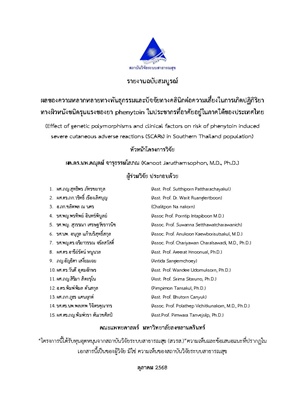| dc.contributor.author | คณุตม์ จารุธรรมโสภณ | th_TH |
| dc.contributor.author | Kanoot Jaruthamsophon | th_TH |
| dc.contributor.author | สุทธิพร ภัทรชยากุล | th_TH |
| dc.contributor.author | Sutthiporn Pattharachayakul | th_TH |
| dc.contributor.author | วริทธิ์ เรืองเลิศบุญ | th_TH |
| dc.contributor.author | Warit Ruanglertboon | th_TH |
| dc.contributor.author | ชลิตพล ณ นคร | th_TH |
| dc.contributor.author | Chalitpon Na Nakorn | th_TH |
| dc.contributor.author | พรทิพย์ อินทร์พิบูลย์ | th_TH |
| dc.contributor.author | Porntip Intapiboon | th_TH |
| dc.contributor.author | สุวรรณา เศรษฐวัชราวนิช | th_TH |
| dc.contributor.author | Suwanna Setthawatcharawanich | th_TH |
| dc.contributor.author | อนุกูล แก้วบริสุทธิ์สกุล | th_TH |
| dc.contributor.author | Anukoon Kaewborisutsakul | th_TH |
| dc.contributor.author | ฉริยาวรรณ จรัลสวัสดิ์ | th_TH |
| dc.contributor.author | Chariyawan Charalsawadi | th_TH |
| dc.contributor.author | อารีย์รัตน์ หนูนวล | th_TH |
| dc.contributor.author | Areerat Hnoonual | th_TH |
| dc.contributor.author | อัญธิดา เสงี่ยมเฉย | th_TH |
| dc.contributor.author | Antida Sangiemchoey | th_TH |
| dc.contributor.author | วันดี อุดมอักษร | th_TH |
| dc.contributor.author | Wandee Udomuksorn | th_TH |
| dc.contributor.author | สิริมา สิตะรุโน | th_TH |
| dc.contributor.author | Sirima Sitaruno | th_TH |
| dc.contributor.author | พิมพ์พิมล ตันสกุล | th_TH |
| dc.contributor.author | Pimpimon Tansakul | th_TH |
| dc.contributor.author | ภูธร แคนยุกต์ | th_TH |
| dc.contributor.author | Bhutorn Canyuk | th_TH |
| dc.contributor.author | พลเทพ วิจิตรคุณากร | th_TH |
| dc.contributor.author | Polathep Vichitkunakorn | th_TH |
| dc.contributor.author | พิมพ์วรา ตันเวชศิลป์ | th_TH |
| dc.contributor.author | Pimwara Tanvejsilp | th_TH |
| dc.date.accessioned | 2025-10-30T02:44:33Z | |
| dc.date.available | 2025-10-30T02:44:33Z | |
| dc.date.issued | 2568-10 | |
| dc.identifier.other | hs3326 | |
| dc.identifier.uri | http://hdl.handle.net/11228/6359 | |
| dc.description.abstract | ยา phenytoin เป็นยากันชักที่มีการใช้กันมานาน และยังคงมีการใช้ในปริมาณที่ค่อนข้างมากในปัจจุบัน โดยข้อมูลจากโรงพยาบาลสงขลานครินทร์ พบว่าในปี พ.ศ. 2562 มีปริมาณการสั่งใช้ phenytoin ทุกรูปแบบในผู้ป่วยนอก 1,970 ใบสั่ง และผู้ป่วยใน 2,583 ใบสั่ง ในแง่ของความปลอดภัยจากการใช้ยา phenytoin มีรายงานจากศูนย์เฝ้าระวังความปลอดภัยด้านผลิตภัณฑ์สุขภาพ สำนักงานคณะกรรมการอาหารและยาในปี พ.ศ. 2560 ว่าผู้ป่วยเกิด Stevens Johnson Syndrome (SJS) และ Toxic Epidermal Necrolysis (TEN) ซึ่งจัดว่าเป็นปฏิกิริยาทางผิวหนังชนิดรุนแรง (severe cutaneous adverse reactions ; SCARs) จากยา phenytoin จำนวน 1,314 ราย และ 124 ราย ตามลำดับ มีข้อมูลจากหลายการศึกษาในหลายกลุ่มประชากร ที่พบว่าความหลากหลายทางพันธุกรรมของยีน Human Leukocyte Antigen (HLA) หลากหลายชนิดอาจส่งผลต่อการเกิด SCARs แต่กลับไม่มีลักษณะพันธุกรรมใดที่สามารถใช้พยากรณ์ป้องกันได้อย่างมีประสิทธิภาพจริงในประชากรไทย นอกจากนี้ด้วยลักษณะจำเพาะที่พื้นที่ภาคใต้ของประเทศไทยอยู่ติดกับประเทศมาเลเซีย ทำให้มีลักษณะจำเพาะทางชาติพันธุ์และลักษณะทางพันธุกรรมของประชากรแตกต่างจากประชากรส่วนอื่นของประเทศ นอกจากนี้แล้วการใช้สิ่งบ่งชี้ทางพันธุกรรมเพื่อทำนายการแพ้ยามักพบข้อจำกัดด้านความแม่นยำในการทำนาย ซึ่งเป็นอุปสรรคต่อการนำสิ่งบ่งชี้ดังกล่าวไปใช้ประโยชน์จริงในทางคลินิก โครงการวิจัยนี้ ผู้วิจัยมีสมมติฐานว่า หากการพิจารณาปัจจัยทางคลินิกเข้าพิจารณาร่วมกับปัจจัยทางพันธุกรรม จะสามารถช่วยให้พยากรณ์การแพ้ยาได้อย่างแม่นยำมากยิ่งขึ้น การศึกษานี้จึงออกแบบ 2 โครงการย่อยโดยโครงการขั้นตอนแรกทำการวิเคราะห์ข้อมูลหลากหลายมิติจากฐานข้อมูลขนาดใหญ่ของโรงพยาบาลสงขลานครินทร์ และทำการสร้าง predictive modelling ควบคู่ไปกับการทำจำลองสถานการณ์ (simulation) ด้วยเทคนิคด้านปัญญาประดิษฐ์ (machine learning) ก็จะนำไปสู่ความสามารถในการคาดการณ์ความเสี่ยงต่อการเกิดอาการแพ้ยา ในโครงการขั้นตอนที่ 2 จะนำผลที่ได้มาศึกษาเชื่อมโยงกับความสัมพันธ์กับลักษณะทางพันธุกรรมในลักษณะ case-control association study เพื่อใช้ลักษณะทางคลินิกร่วมกับลักษณะพันธุกรรมมาสร้างแบบจำลองการพยากรณ์การแพ้ยาในประชากรภาคใต้ของไทย การศึกษานี้คาดหวังว่าจะสร้างผลกระทบเชิงบวกต่อผู้รับบริการและหน่วยงานด้านการบริการด้านสุขภาพต่อไป | th_TH |
| dc.description.sponsorship | สถาบันวิจัยระบบสาธารณสุข | th_TH |
| dc.language.iso | th | th_TH |
| dc.publisher | สถาบันวิจัยระบบสาธารณสุข | th_TH |
| dc.rights | สถาบันวิจัยระบบสาธารณสุข | th_TH |
| dc.subject | Phenytoin | th_TH |
| dc.subject | เฟนิโทอิน | th_TH |
| dc.subject | การแพ้ยา | th_TH |
| dc.subject | Pharmacogenetics | th_TH |
| dc.subject | Drug Reactions | th_TH |
| dc.subject | Precision Medicine | th_TH |
| dc.subject | Genomics | th_TH |
| dc.subject | จีโนมิกส์ | th_TH |
| dc.subject | การบริการสุขภาพ (Health Service Delivery) | th_TH |
| dc.title | ผลของความหลากหลายทางพันธุกรรมและปัจจัยทางคลินิกต่อความเสี่ยงในการเกิดปฏิกิริยาทางผิวหนังชนิดรุนแรงของยา phenytoin ในประชากรที่อาศัยอยู่ในภาคใต้ของประเทศไทย | th_TH |
| dc.title.alternative | Effect of Genetic Polymorphisms and Clinical Factors on Risk of Phenytoin Induced Severe Cutaneous Adverse Reactions (SCARs) in Southern Thailand Population | th_TH |
| dc.type | Technical Report | th_TH |
| dc.description.abstractalternative | Phenytoin is a long-established anticonvulsant that remains in substantial use presently. Data
from Songklanagarind Hospital in 2019 reveals that 1,970 outpatient and 2,583 inpatient
prescriptions for phenytoin were dispensed. Reports from the Health Product Vigilance Center
of the Thai Food and Drug Administration in 2017 documented 1,314 cases of Stevens-Johnson
Syndrome (SJS) and 124 cases of Toxic Epidermal Necrolysis (TEN), both classified as severe
cutaneous adverse reactions (SCARs), attributed to phenytoin. Numerous studies across diverse
populations have suggested associations between various genetic polymorphisms and SCARs
induced by phenytoin. Nevertheless, no genetic markers provided a promising predictability for
these adverse drug reactions in the Thai population. Furthermore, the unique anthropological
origin of Southern Thai populations also contributes to distinct genetic characteristics which
makes the clinical implication of pharmacogenetic markers more challenging. This research
project aimed to evaluate clinical factors along with genetic markers towards a better
understanding of phenytoin-induced adverse reactions. The study consisted of two phases: the
first phase involved multidimensional data analysis of a large database from Songklanagarind
Hospital to evaluate the influence of clinical parameters in a real-world dataset. The second
phase investigated the association between these predictive outcomes and genetic markers
through a case-control association study. The combined clinical and genetic data will be used
to construct a predictive model for adverse drug reactions. | th_TH |
| dc.identifier.contactno | 66-128 | |
| dc.subject.keyword | การแพทย์แม่นยำ | th_TH |
| dc.subject.keyword | การรักษาอย่างแม่นยำ | th_TH |
| dc.subject.keyword | การรักษาแบบแม่นยำ | th_TH |
| dc.subject.keyword | การแพทย์เฉพาะบุคคล | th_TH |
| .custom.citation | คณุตม์ จารุธรรมโสภณ, Kanoot Jaruthamsophon, สุทธิพร ภัทรชยากุล, Sutthiporn Pattharachayakul, วริทธิ์ เรืองเลิศบุญ, Warit Ruanglertboon, ชลิตพล ณ นคร, Chalitpon Na Nakorn, พรทิพย์ อินทร์พิบูลย์, Porntip Intapiboon, สุวรรณา เศรษฐวัชราวนิช, Suwanna Setthawatcharawanich, อนุกูล แก้วบริสุทธิ์สกุล, Anukoon Kaewborisutsakul, ฉริยาวรรณ จรัลสวัสดิ์, Chariyawan Charalsawadi, อารีย์รัตน์ หนูนวล, Areerat Hnoonual, อัญธิดา เสงี่ยมเฉย, Antida Sangiemchoey, วันดี อุดมอักษร, Wandee Udomuksorn, สิริมา สิตะรุโน, Sirima Sitaruno, พิมพ์พิมล ตันสกุล, Pimpimon Tansakul, ภูธร แคนยุกต์, Bhutorn Canyuk, พลเทพ วิจิตรคุณากร, Polathep Vichitkunakorn, พิมพ์วรา ตันเวชศิลป์ and Pimwara Tanvejsilp. "ผลของความหลากหลายทางพันธุกรรมและปัจจัยทางคลินิกต่อความเสี่ยงในการเกิดปฏิกิริยาทางผิวหนังชนิดรุนแรงของยา phenytoin ในประชากรที่อาศัยอยู่ในภาคใต้ของประเทศไทย." 2568. <a href="http://hdl.handle.net/11228/6359">http://hdl.handle.net/11228/6359</a>. | |
| .custom.total_download | 3 | |
| .custom.downloaded_today | 3 | |
| .custom.downloaded_this_month | 3 | |
| .custom.downloaded_this_year | 3 | |
| .custom.downloaded_fiscal_year | 3 | |


